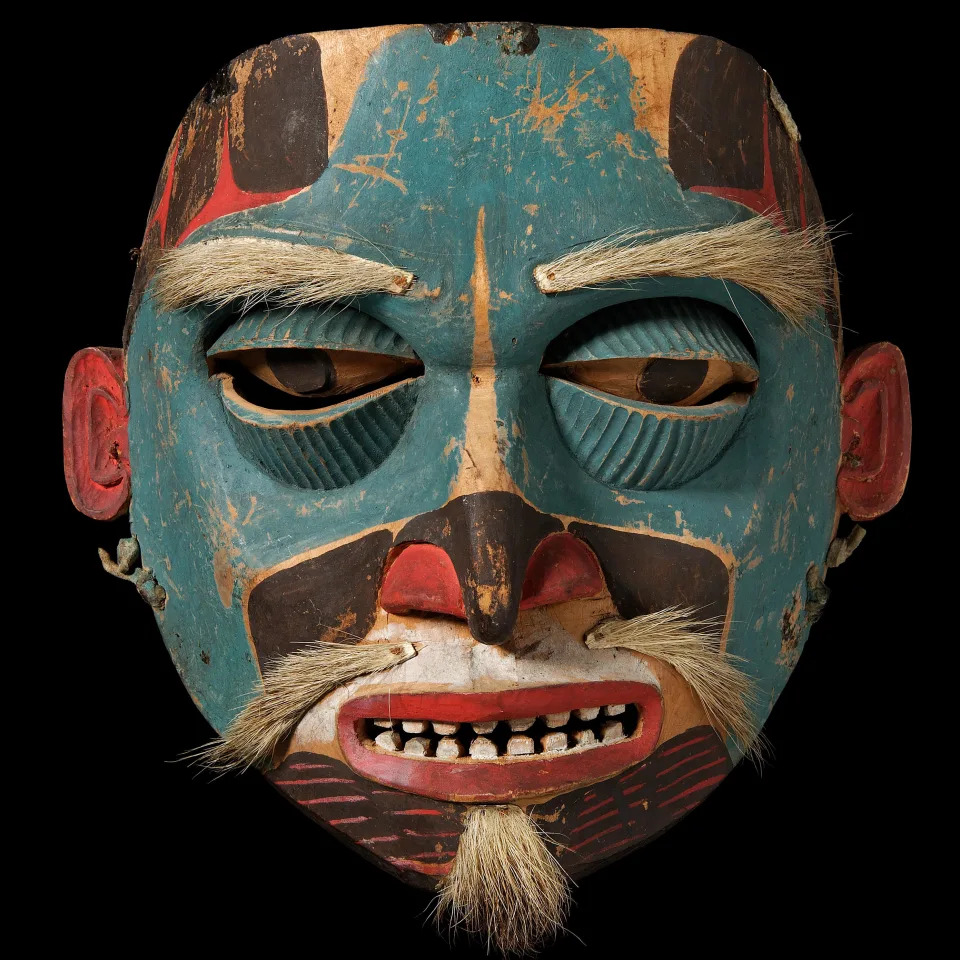Jonathan Jones
Fri, 10 March 2023

When the artist Simeon Stilthda saw a picture of Egypt’s Great Sphinx in a missionary bible in the 1870s, he carved his own version of it. Stilthda was a member of the Haida people in the Pacific Northwest of the Americas and his carving was a tribute from the indigenous culture of this region to ancient Egypt, thousands of miles and years away. It’s not just a wonderful sculpture – round the back, the Sphinx has a Haida hairstyle – but a piece of art theory in wood. Stilthda draws eye-opening parallels between his community’s religious art and that of the Pharaohs.
Like the ancient Egyptians who conjoined a human and lion to create the Sphinx, the Indigenous peoples of North America’s Pacific Northwest have a magical eye for nature. This compelling exhibition transports you to vast coniferous forests and the open ocean where humans and animals are close. This style of Pacific Northwest art, with its blocky curved patterns, appears to emulate the black and white markings of one of the region’s ruling creatures, the killer whale. Not only do orcas feature on totem poles along with birds mythic and real, but their “abstract” appearance is reflected in a style that brilliantly stretches and warps reality.
Empowering Art is a radical and satisfying survey of nearly 250 years of Pacific Northwest culture, created in close collaboration with Indigenous artists and scholars, and drawing on Britain’s extensive collections of the art of the Haida, Tlingit, Nuu-chah-nulth and other communities. In 1778 the British explorer James Cook led the first European meeting with these peoples: at that time, writes artist haa’yuups in the catalogue, “virtually every man in each of our villages on the Westcoast could carve a dugout canoe, paddles, dishes and spoons … every man was his own Leonardo”. The power of these popular traditions, already millennia old, can be seen in 18th-century prints of the objects Cook collected: a mask in the shape of an otter’s head proves the later naturalism of masks by Stillthda – which imitate real faces uncannily – was not just an impression of the whites’ art but an Indigenous heritage.
This enthusiastic exhibition seems to me to reveal the way forward for exhibiting world art at a time when some believe the very ownership of “ethnographic” pieces by Britain’s museums is wrong. There are works here from Oxford’s Pitt Rivers Museum, the British Museum, the Wellcome and not least Ipswich Borough council: “some gifted, some traded, some stolen”, as haa’yuups writes. There are also contemporary artworks, from a 21st-century totem pole to video installations, that reveal a fiercely, joyously living culture. The show has a historical clarity that doesn’t disguise the violence Indigenous peoples have suffered but goes beyond the restitution debate to open up all the wonder and dreaming and sorrow these objects contain.
The masks alone are enough to inspire whole theories of art – and they have done. Anthropologists like Claude Lévi-Strauss and Franz Boas were fascinated by the complexity and variety of the ritual masks first brought to Europe by Cook. Here you are greeted by a row of them, fantastic faces that subtly mix myth and fact, imagination and observation: by putting on a 19th-century mask of the Thunderbird you could imitate or even become this mythic creature that waters the earth. Alternatively you could don a vividly mimetic Haida mask of a wrinkled old woman, another entrancing piece lent by the Pitt-Rivers Museum. And, in a contemporary take, you can mask as Marlon Brando.
At the heart of the show is the Potlatch, the weightiest collective event of the Pacific Northwest world. Chiefs and powerful people would invite neighbouring villages to a Potlatch feast where everyone took part in a meal served from beautifully carved wooden bowls: there’s one here in the shape of a canoe. At the Potlatch, everyone got a gift, for this was a world rich in material things.
The combs, figurines, model canoes, fighting knives, straw hats and other chunkily lovely artefacts could all have been Potlatch gifts. The gift relationship was binding: the debt conferred power. But it was the very opposite of capitalism, and perhaps that was why it was specifically banned by Canada in 1885. The ban lasted until 1951.
The assault on indigenous culture still scars memories and it sends a chill through the exhibition. A wall-filling photograph of the ruinous hulk of St Michael’s residential school is a measured way of documenting these outrageous institutions: right through the 20th-century Indigenous children were taken from their communities, their hair was cut to symbolise the killing of the “Indian” in them, some were sexually as well as physically abused – and worse, as has been shockingly revealed by recent excavations of mass graves.
Sonny Assu (Ligwilda’xw Kwakwaka’wakw) calmly comments on the horror of it with his 2024 artwork Leila’s Desk: on an old wooden school desk sits a bar of soap, symbolising what actually happened to his grandmother when she was made to wash herself on her first day as school, suddenly made to feel she was a “dirty Indian”.
The final display of contemporary north-west Pacific creativity could seem sentimental in the face of such brutality. But it’s a convincing testimony to the endurance and survival of a rare artistic vision. The patterns and creatures of traditional art are engraved into the skyline of Montreal and projected on to the walls of a room you want to dance in.
These mind-bending designs don’t need to be analysed, only enjoyed and shared. And everything in the show has a universal lesson for us now. For each object here contains the secret of living inside nature, alongside the otter and the whale.
Empowering Art: Indigenous Creativity and Activism from North America’s Northwest Coast is at the Sainsbury Centre, Norwich, from 12 March 2023.
No comments:
Post a Comment